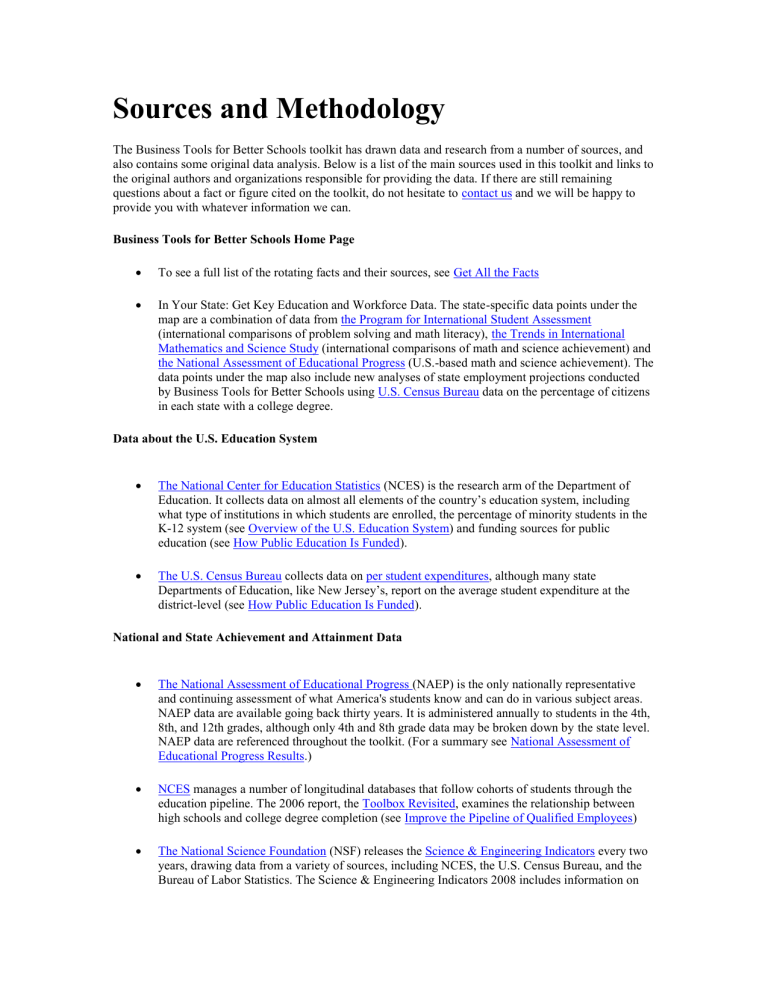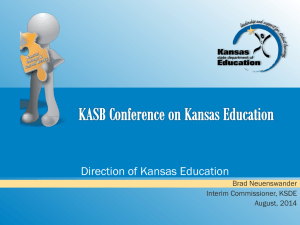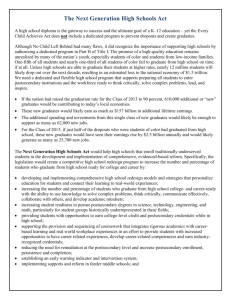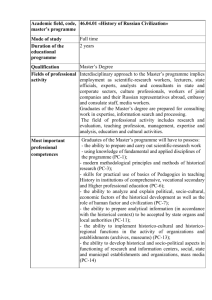The Business Tools for Better Schools toolkit has drawn data and

Sources and Methodology
The Business Tools for Better Schools toolkit has drawn data and research from a number of sources, and also contains some original data analysis. Below is a list of the main sources used in this toolkit and links to the original authors and organizations responsible for providing the data. If there are still remaining questions about a fact or figure cited on the toolkit, do not hesitate to contact us and we will be happy to provide you with whatever information we can.
Business Tools for Better Schools Home Page
To see a full list of the rotating facts and their sources, see Get All the Facts
In Your State: Get Key Education and Workforce Data. The state-specific data points under the map are a combination of data from the Program for International Student Assessment
(international comparisons of problem solving and math literacy), the Trends in International
Mathematics and Science Study (international comparisons of math and science achievement) and the National Assessment of Educational Progress (U.S.-based math and science achievement). The data points under the map also include new analyses of state employment projections conducted by Business Tools for Better Schools using U.S. Census Bureau data on the percentage of citizens in each state with a college degree.
Data about the U.S. Education System
The National Center for Education Statistics (NCES) is the research arm of the Department of
Education. It collects data on almost all elements of the country’s education system, including what type of institutions in which students are enrolled, the percentage of minority students in the
K-12 system (see Overview of the U.S. Education System ) and funding sources for public education (see How Public Education Is Funded ).
The U.S. Census Bureau collects data on per student expenditures , although many state
Departments of Education, like New Jersey’s, report on the average student expenditure at the district-level (see How Public Education Is Funded ).
National and State Achievement and Attainment Data
The National Assessment of Educational Progress (NAEP) is the only nationally representative and continuing assessment of what America's students know and can do in various subject areas.
NAEP data are available going back thirty years. It is administered annually to students in the 4th,
8th, and 12th grades, although only 4th and 8th grade data may be broken down by the state level.
NAEP data are referenced throughout the toolkit. (For a summary see National Assessment of
Educational Progress Results .)
NCES manages a number of longitudinal databases that follow cohorts of students through the education pipeline. The 2006 report, the Toolbox Revisited , examines the relationship between high schools and college degree completion (see Improve the Pipeline of Qualified Employees )
The National Science Foundation (NSF) releases the Science & Engineering Indicators every two years, drawing data from a variety of sources, including NCES, the U.S. Census Bureau, and the
Bureau of Labor Statistics. The Science & Engineering Indicators 2008 includes information on
science and engineering bachelor’s degree attainment (see America Is Losing Its Competitive
Edge ).
The Manhattan Institute has done significant research analyzing the variety of graduation rate measures currently used throughout the U.S. Such methods include those of NCES, the
Cumulative Promotion Index, and state-reported graduation rates (see The Level of Educational
Attainment ).
The U.S. Census Bureau also collects data on state and national education attainment , often as a percentage of the population that has attained at least a high school diploma, associate’s degree or bachelor’s degree and higher. The Census Bureau also disaggregates by age group (see The Level of Educational Attainment ).
International Achievement Data
The Program for International Student Assessment (PISA) is an assessment given to a representative sample of 15 year olds in 39 countries every three years, focusing on problem solving and subject literacy rather than specific course content, to allow for cross-country comparisons.
The Trends in International Mathematics and Science Study (TIMSS) is an assessment given to 4th- and 8th-graders in over 40 countries to measure their mastery of curriculum-based mathematics and science knowledge and skills. TIMSS data were collected in 1995, 1999 and
2003, with additional assessments planned for the future (see Maintain America’s Competitive
Edge ).
International Attainment Data
The Organization for Economic Cooperation and Development (OECD) issues Education at a
Glance annually, highlighting a variety of education achievement, attainment and opportunities indicators from over 40 countries.
National & State Employment Projections
The Bureau of Labor Statistics (BLS) provides data on current and projected employment conditions, including how many new jobs are expected to be created in the next ten years, and what level of education and training will be required of those jobs. The BLS also conducts research on the projected lifetime earning expectations and unemployment rates associated with each level of education (see Improve the Pipeline of Qualified Employees , Maintain America’s
Competitive Edge in the Global Economy , Grow the U.S. Economy and the Customer Base , High
School Graduates Are Not Prepared for College and Careers , America is Losing Its Innovative
Edge ).
Business Tools for Better Schools identified the percentage of each state’s fastest growing jobs that will require some college or postsecondary training by finding how many of the thirty fastest growing jobs (as identified by the BLS) each state is projected to have by 2012, using
ProjectionsCentral.com, a database of state-level employment projections. Once we identified how many positions each state is predicted to have within these thirty jobs, using criteria developed by the BLS we determined how many of these predicted jobs would require some college or postsecondary training. By dividing the number of projected new jobs requiring college or
postsecondary training by the total number of the projected fastest growing jobs, we found the percentage of the fastest growing jobs that would require some college or the equivalent training in each state (see Business Tools for Better Schools ).
International Employment Data
The National Science Foundation’s Science & Engineering Indicators 2008 report includes international comparisons in degree attainment and employment projections (see Getting More
Innovation Workers in the Pipeline , Maintain America’s Competitive Edge ).
Remediation Data
Jay Greene’s analysis of the cost of remediation, conducted for the Mackinac Center in Michigan, estimates that companies and colleges spend upwards of $17 billion per year to train recent graduates in the basic skills they should have gained in school (see Case for Action
Overview , Improve the Pipeline of Qualified Employees and High School Graduates Are Not
Prepared for College and Careers ).
The Alliance for Excellent Education released a report in 2006 estimating that the U.S. loses $2.3 billion each year due to loss of productivity from college dropouts (see Case for Action Overview ;
Grow the U.S. Economy and the Customer Base ).
NCES also tracks remediation rates at degree-granting postsecondary institutions to determine how many students require remediation upon enrolling in college (see High School Graduates Are
Not Ready for Work and College ).
College- and Career-Readiness Data
The National Association of Manufacturers conducted a survey of employers in 2005 on their hiring practices and challenges they were facing filling open positions (see Improve the Pipeline of
Qualified Employees , Preparing All Graduates for College and Careers ).
Achieve commissioned Peter D. Hart to conduct a survey of recent high school graduates in college and the workforce; college professors; and employers to find out how each group felt about the level of preparation high school had provided the graduates (see Improve the Pipeline of
Qualified Employees , Open More Doors for America’s Youth , Preparing All Graduates for
College and Careers ).







